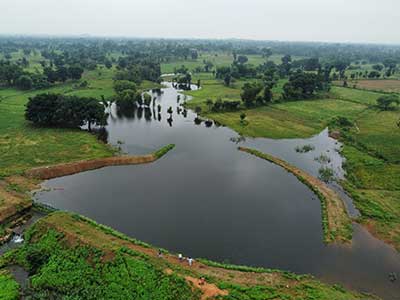Date: 24/03/2023
Relevance: GS-3: Conservation, environmental pollution and degradation, environmental impact assessment.
Key Phrases: Small Water Bodies, United Nation, Central Water Commission Of India, Animal Husbandry, Agriculture, Net Irrigated Area, Minor Irrigation Census, Kudimaramatu System.
Context:
- The significance of water in driving economic development and alleviating poverty cannot be overstated. Unfortunately, concerning developments in the water sector have emerged from various sources in recent years.
- According to the United Nations water website, during the early to mid-2010s, around 1.9 billion individuals, accounting for 27 percent of the world's population, resided in regions with severe water scarcity. However, this figure is projected to escalate to 2.7-3.2 billion individuals by the year 2050.
Key Highlights:
- According to the Water and Related Statistics (2021) report by the Central Water Commission of India, it is projected that by 2025, one in three people will reside in a water-stressed region. This highlights the critical need to increase the water supply in every way possible to prevent an impending water crisis.
- Regrettably, the small water bodies such as tanks that have been instrumental in meeting the agricultural and domestic water requirements in India for several years are rapidly disappearing.
The Current State of SWBs:
- Research suggests that rainfall is not the primary cause. The reduction of irrigated area by SWBs is due to continuous encroachment on catchment areas and flow canals, which carry rainwater to tanks, and lack of annual maintenance of tanks by allocating sufficient funds.
- In 1960-61, the area irrigated by tanks in India was 46.30
lakh hectares (lha), but by 2019-20, it had decreased to 16.68 lha,
resulting in tank area's share in India's net irrigated area (NIA) falling
from 20% to 2%.
- Tank irrigation in Tamil Nadu, which accounted for one-third of the irrigated area in the 1960s and 1970s, decreased from 9.36 lha to 3.72 lha during this period, leading to farmers who relied on tank irrigation to abandon agriculture or leave the land fallow.
- Despite good rainfall, the area irrigated by tanks has not increased in Tamil Nadu, and this trend is also observed in other states.
- The urban agglomeration witnessed from the 1990s has severely
impacted SWBs, converting many of them into dumping grounds.
- The Standing Committee on Water Resources (2012-13) highlighted in its 16th report that most water bodies in the country were encroached upon by State agencies themselves.
- According to the 5th Minor Irrigation Census published in 2017 by
the Ministry of Water Resources, the number of surface minor irrigation
schemes decreased from 6, 01,000 in 2006-07 to 5, 92,000 in 2013-14.
- Reduction in the number of SWBs is observed in most states, and the Standing Committee on Water Resources (2012-13) estimated that about one million hectares of irrigation potential were lost due to encroachment and other reasons.
Decline of SWBs Matters:
- Despite their small size, Small Water Bodies (SWBs) have significant benefits. They are distributed throughout the country and provide easy access to water for various purposes, such as domestic needs, animal husbandry, drinking water, and agriculture.
- SWBs have distinct features compared to other water sources, such as canal and groundwater. They are easily manageable due to their small size and have a low maintenance cost compared to canal irrigation, which has become increasingly expensive over time.
- SWBs typically have a small command area, irrigating around
100-500 acres, which allows for efficient water distribution without
conflicts between head-reach and tail-end farmers, a common problem in canal
command areas.
- This reduces the poverty of small and marginal farmers who benefit the most from SWBs.
- Increased water storage from SWBs also helps in recharging groundwater. Additionally, as SWBs are present in every village, women don't have to travel far to fetch water for their drinking needs.
Conclusion:
- The Central Groundwater Board warns that the neglect of small
water bodies (SWBs) could lead to the collapse of well recharge mechanisms,
resulting in wells running dry.
- The number of over-exploited/critical/semi-critical blocks has increased from 1,645 to 2,538 between 2004 and 2020, highlighting the urgency of the situation.
- SWBs need to be repaired, restored, and renovated to prevent the
collapse of the recharge mechanism of wells and ensure the availability of
water.
- Legislation should be enacted to make encroachment on water bodies a cognizable offense.
- Following the judgment of the Madras High Court, approval for the layout or building plan on lands located on SWBs should not be given.
- A separate Ministry for Small Water Bodies should be created with
adequate funding to conduct periodic repair and rehabilitation works.
- Farmers should set up a tank users’ organization and undertake the repairing of SWBs under the Kudimaramathu system.
- Corporates should repair and renovate SWBs under the ambit of corporate social responsibility.
- Swift actions need to be taken to save SWBs, or they will slowly disappear, aggravating the water woes.
Source: The Business Line
Mains Question:
Q. "Discuss the causes and consequences of neglecting Small Water Bodies (SWBs) in India. What steps should policymakers take to prevent the collapse of the recharge mechanism of wells and ensure the sustainable management of water resources?" (250 words).







